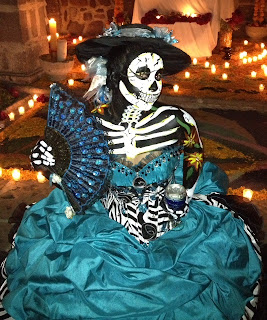Some days have passed since the celebration of Day of the Dead, and maybe during those days you heard about this popular Mexican character, and maybe you were wondering about her origins and the reason of her popularity.
If you haven't really heard from her, la Calavera Catrina is a fancy skeleton lady who wears pretty dresses and elaborate hats (just like the first photo shows). Actually, for many years the Spanish word "catrín" has been used in Mexico to define an elegant or fancy gentleman, in the same way "catrina" is used to call an upper-class lady.
 Her first appearance was in the famous etching called "La Calavera Garbancera" (right), created by the Mexican printmaker José Guadalupe Posada in 1913. Posada wanted to criticize some Mexicans that used to deny their roots and wished to look European and wealthy, but really belonged to a low class. He used to say: ..."en los huesos, pero con sombrero francés con sus plumas de avestruz" (in her bones, but with a French hat with ostrich feathers).
Her first appearance was in the famous etching called "La Calavera Garbancera" (right), created by the Mexican printmaker José Guadalupe Posada in 1913. Posada wanted to criticize some Mexicans that used to deny their roots and wished to look European and wealthy, but really belonged to a low class. He used to say: ..."en los huesos, pero con sombrero francés con sus plumas de avestruz" (in her bones, but with a French hat with ostrich feathers).She was named "la Catrina" by the artist Diego Rivera, when long after Posada's death, he painted her in his mural "Dream of a Sunday in Alameda Park" (left). In this piece, we can see the full body of the fancy skeleton lady, accompanied by Posada.
La Catrina has become an important Mexican icon for the celebration for the Day of the Dead, and we can find her in various ornaments and artcrafts (in fact, she is so popular now that a lot of people like to dress up like her during Day of the Dead celebrations). Actually, it is common for Mexicans to buy clay Catrina figurines to decorate their homes, for that reason, the dresses and posses of this character have become more and more creative. Nowadays we find dancers, singers, musicians, sexy devils, brides, and many more.
The small town of Capula, in the state of Michoacan, Mexico, is famous for making different clay artcrafts, it's the home of great artists, and, in my opinion, the place were you can find the finest Catrinas in the country, not to mention that you don't need to spend a fortune to obtain these fine art pieces. In fact, every year before the Day of the Dead, a Catrina Fair takes place there, so you will find figurines of every shape, size, color and price (they are really cheap, unique and beautiful). Here are some pictures that I took during this year's fair:
I hope that this little post helped you to learn more about this very special Mexican character. Please, feel free to leave any comment.
Sources:
es.wikipedia.org/wiki/La_Catrina
img: artesytradicionesdemexico.com/2012/10/29/de-la-calavera-garbancera-a-la-catrina











